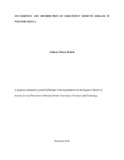OCCURRENCE AND DISTRIBUTION OF GROUNDNUT ROSETTE DISEASE IN WESTERN KENYA
Abstract
Groundnut (Arachis hypogaea L.) is an economically important food legume, grown in Western Kenya. Groundnut rosette disease (GRD) is a major constraint in sub-Saharan Africa, which can cause serious yield losses in an epidemic situation. Rosette is transmitted in nature by the viruliferous aphid vector, Aphis craccivora Koch (Insecta: Homoptera), in a persistent circulative manner. The disease is caused by two synergistic viruses; groundnut rosette assistor virus (GRAV, genus Luteovirus) and groundnut rosette virus (GRV, genus Umbravirus) associated with a satellite-ribonucleic acid (Sat-RNA). The GRD viruses occur in three predominant symptom forms; chlorotic rosette, green rosette and mosaic rosette. This study will determine the symptomatology, occurrence, distribution, biological and molecular characterization of groundnut rosette in Western Kenya. Two disease diagnostic surveys, will be conducted during the short and long rain seasons in eight counties; Bungoma, Busia, Homabay, Kakamega, Migori, Nandi, Siaya and Vihiga. The counties represent the Lower Midland (LM) and Upper Midland (UM) agro-ecological zones (AEZs). Symptomatic leaves will be collected from the groundnut farms. Total RNA will be extracted by RNeasy Mini Kit (Qiagen), and sequenced using next generation sequencing technologies (NGS). Disease incidence and severity will be scored on the disease score sheet. The data collected on occurrence, distribution, diversity and characterization, will be compared by analysis of variance (ANOVA), using Statistical Analysis Software (SAS) program (SAS Institute lnc.). Pairwise comparison of means will be done using Least Significance Difference (LSD) at P ≤ 0.05 confidence level. This research will provide comprehensive knowledge of GRD viruses, rosette symptoms and better agronomic farming technologies, for considerable increased groundnut production.

